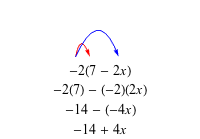This one is insanely important when working with algebraic expressions. The distributive property basically says this:

and

However, the distributive property does not work when the variables inside the parentheses are being multiplied or divided.

and

Let's go through an example very carefully:

By applying the distributive property, we can multiply each term inside the parentheses by 4. This is called "distributing."

Since 12x and 4 are not like terms, this is as far as we can go with the problem.
What about subtraction? Let's look at a subtraction problem using two different methods.

| Method 1 Leave as Subtraction | Method 2 Add the Negative |
|---|---|
 |  |
Either way, we get the same answer: -14 + 4x. What a relief.
 .
.
 .
.